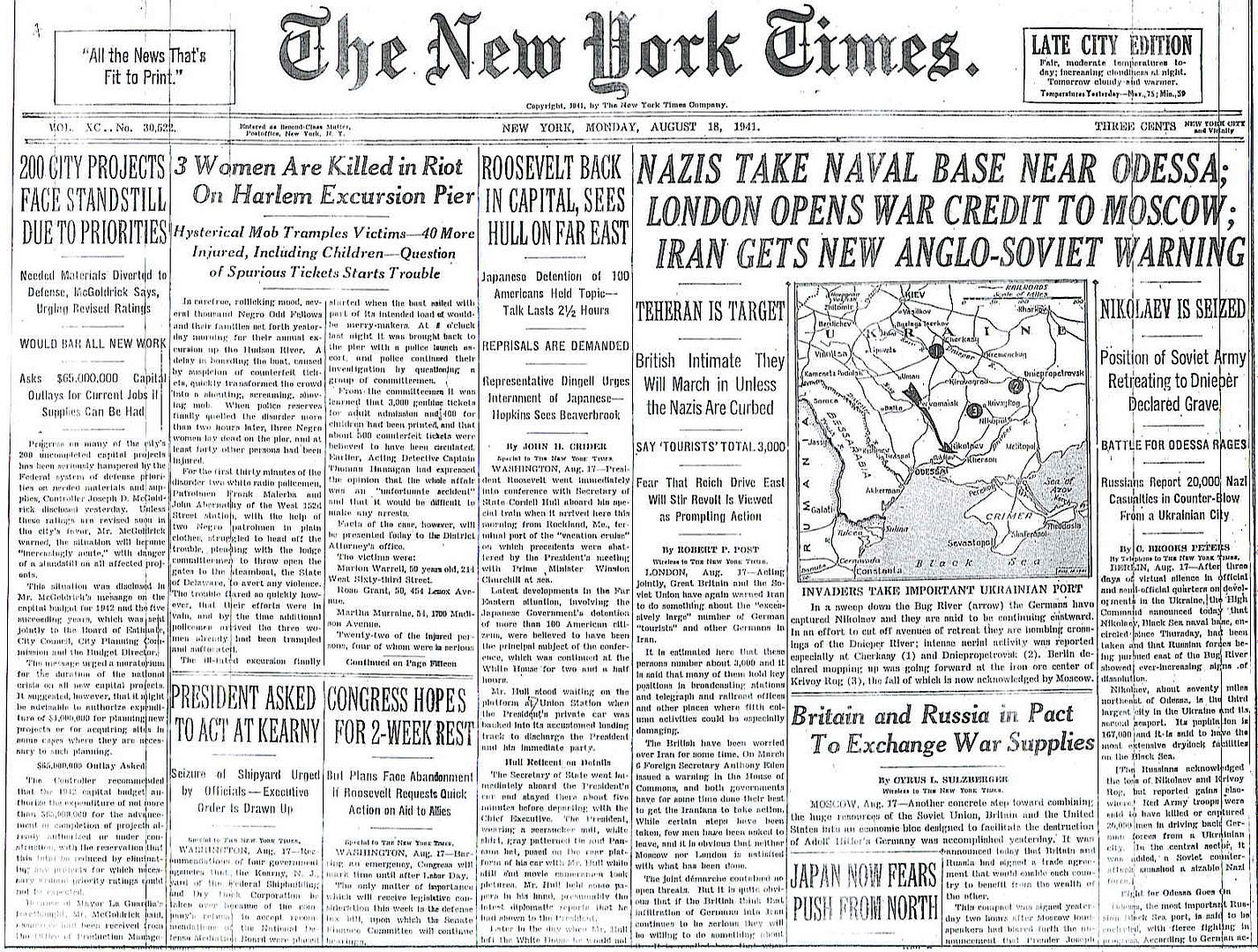
Posted on 08/18/2011 5:28:08 AM PDT by Homer_J_Simpson

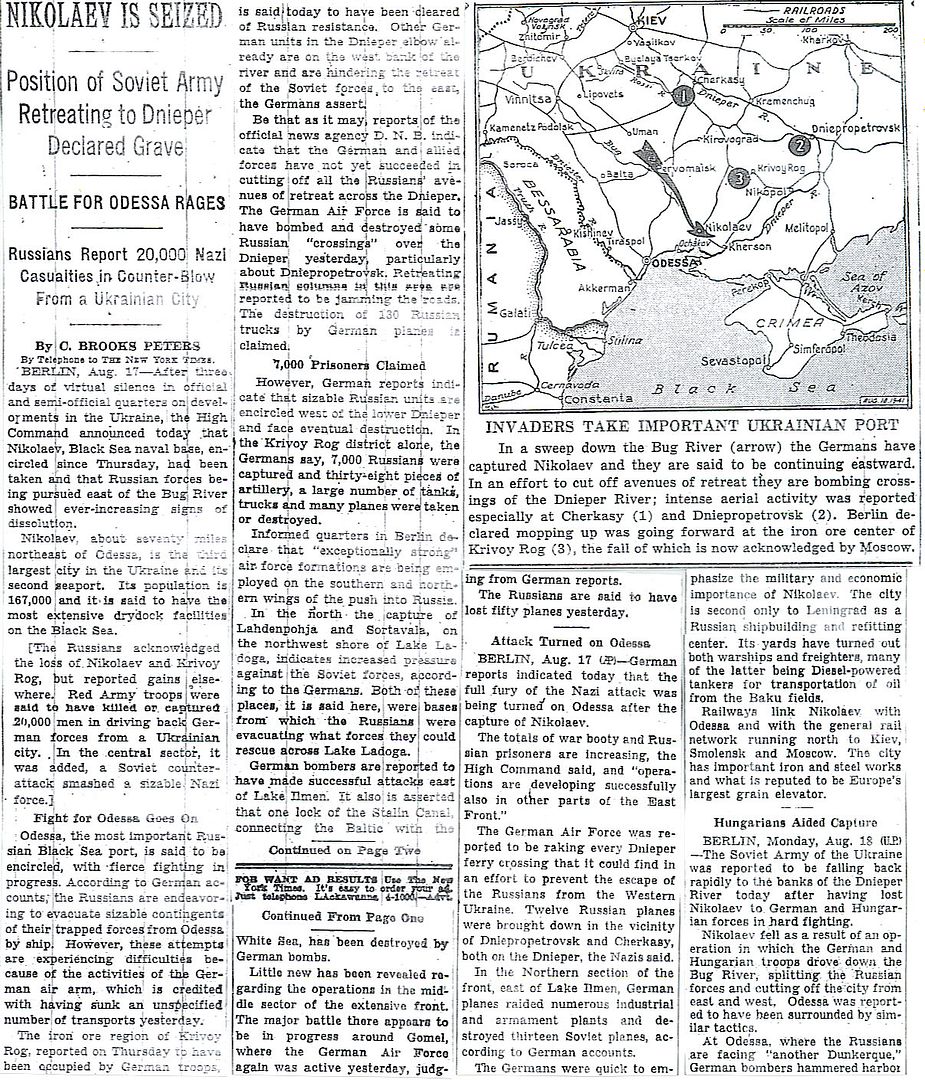
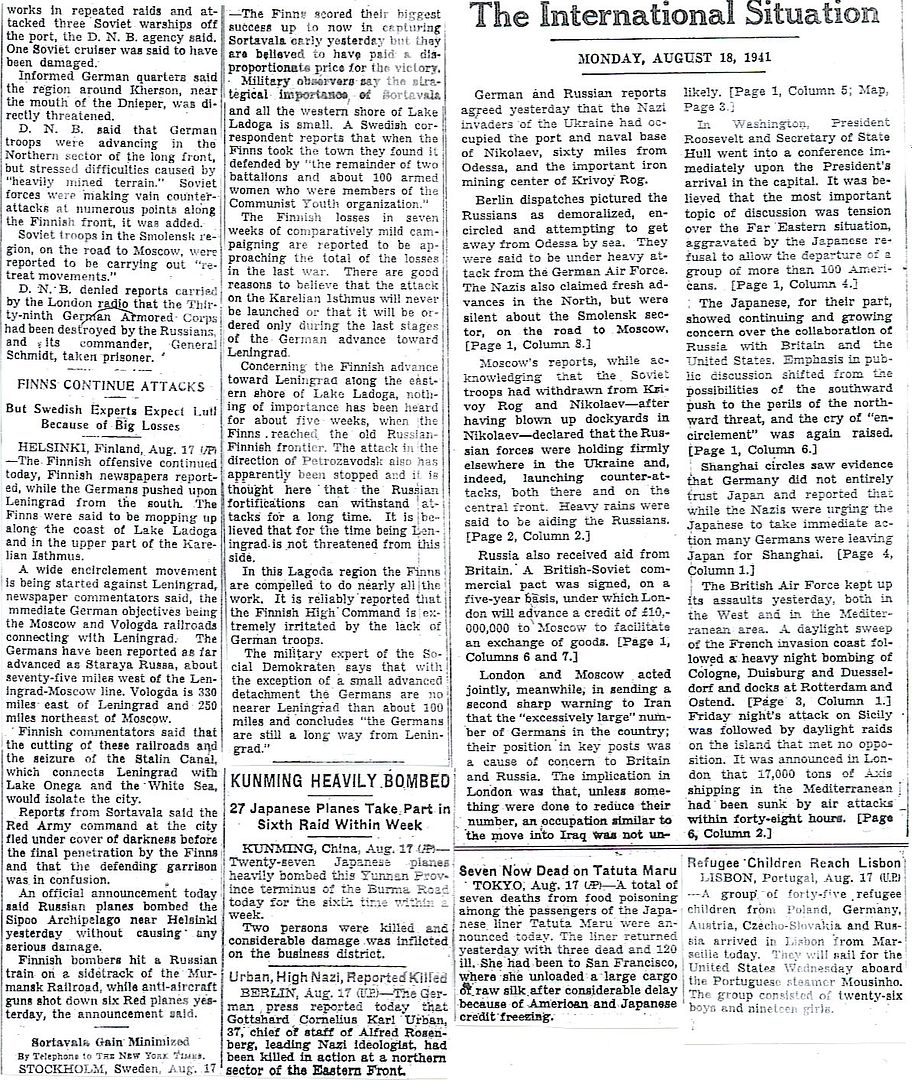

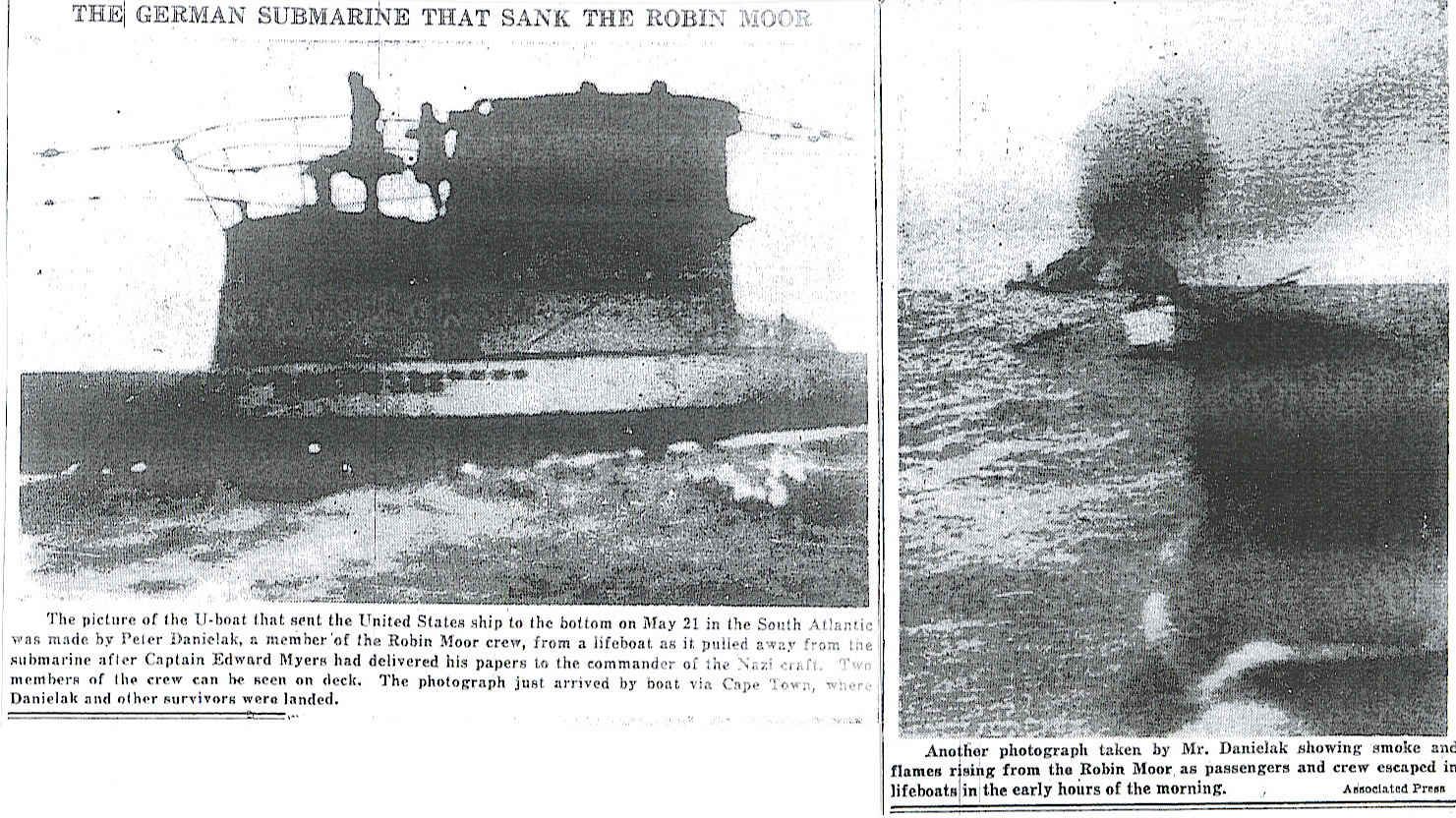
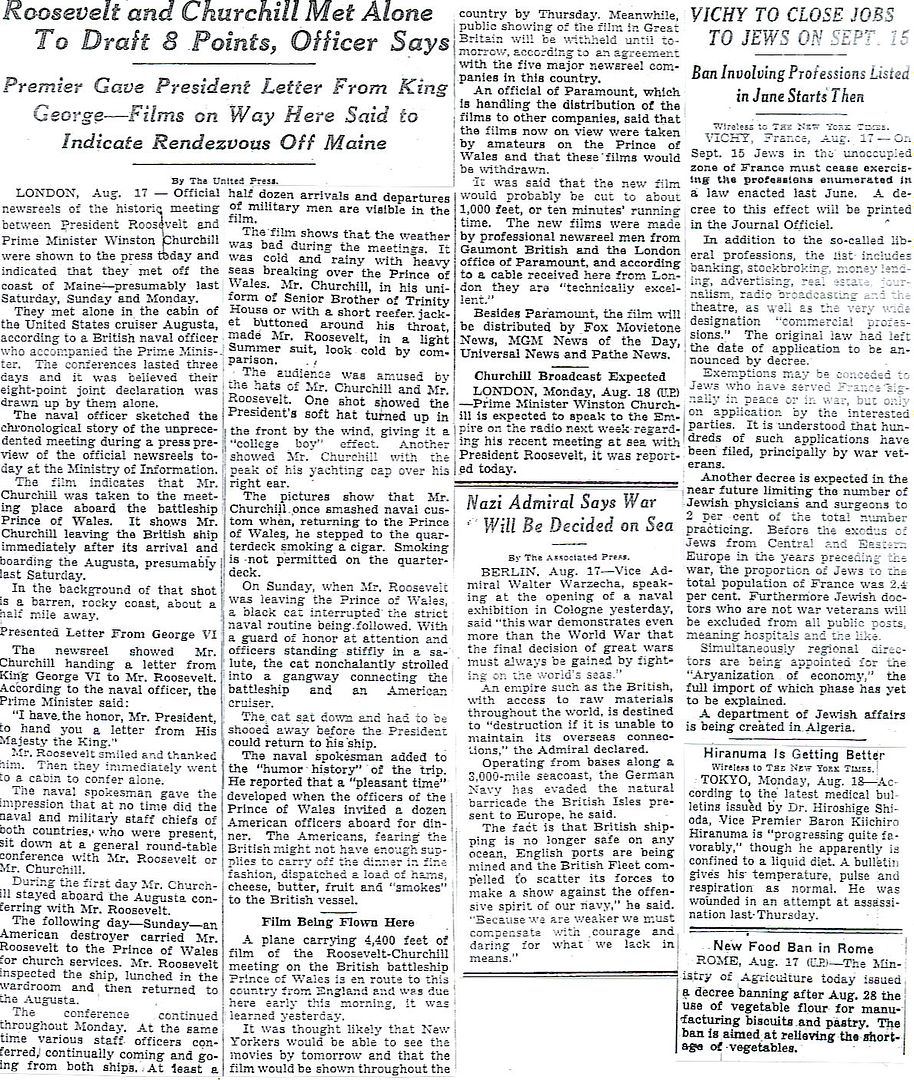
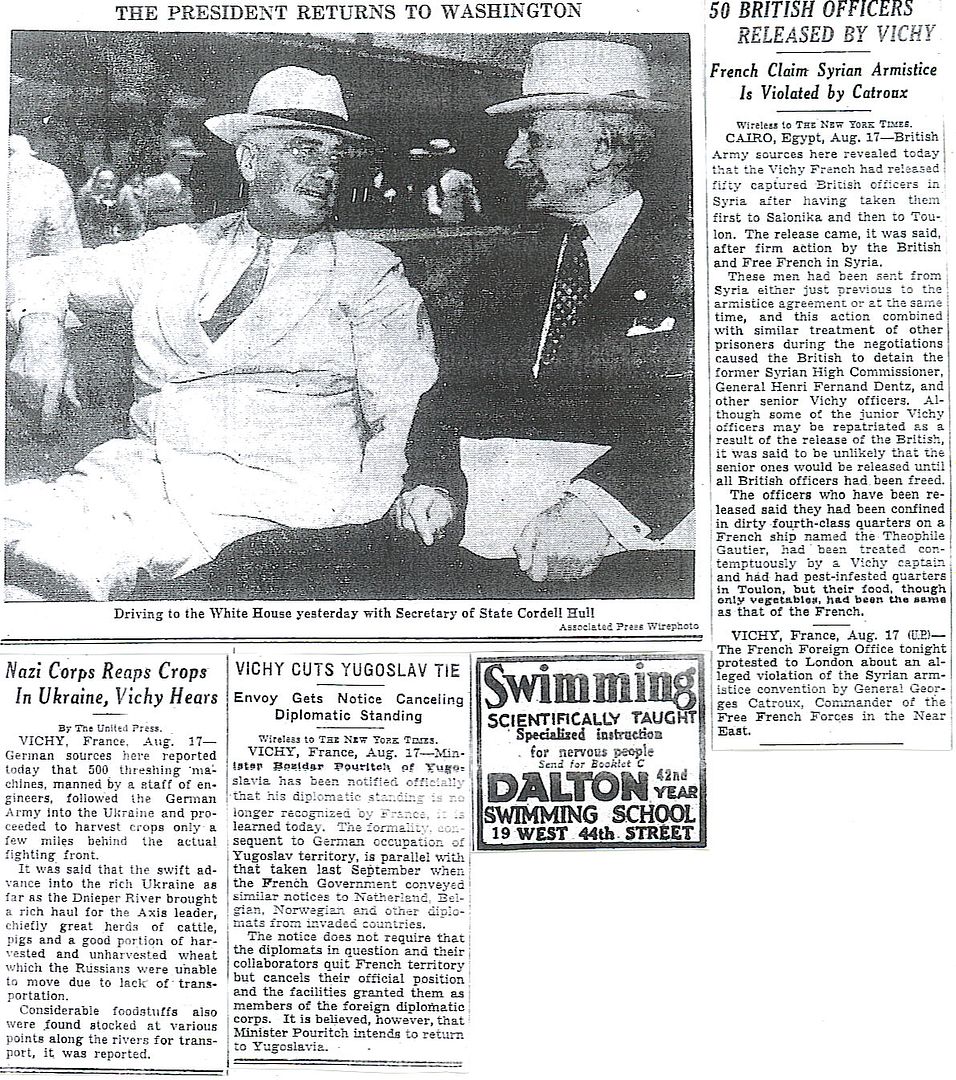
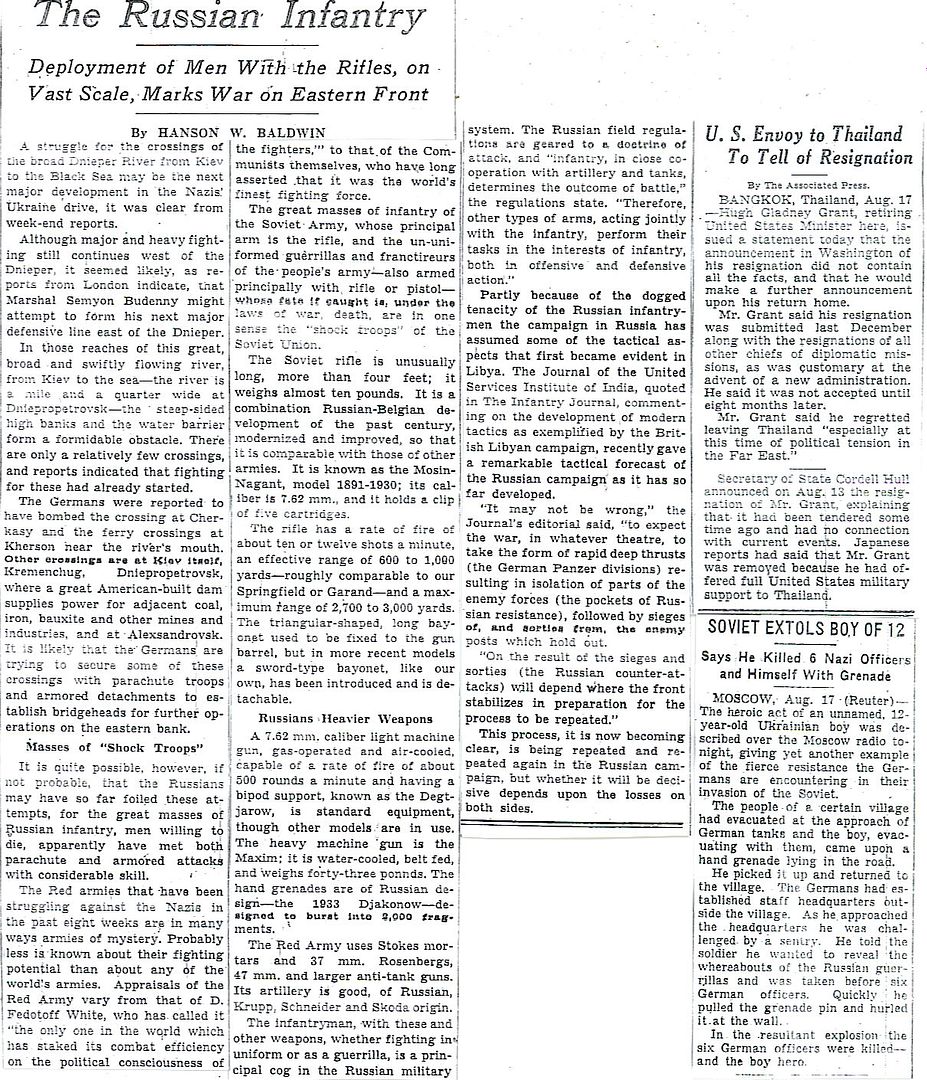
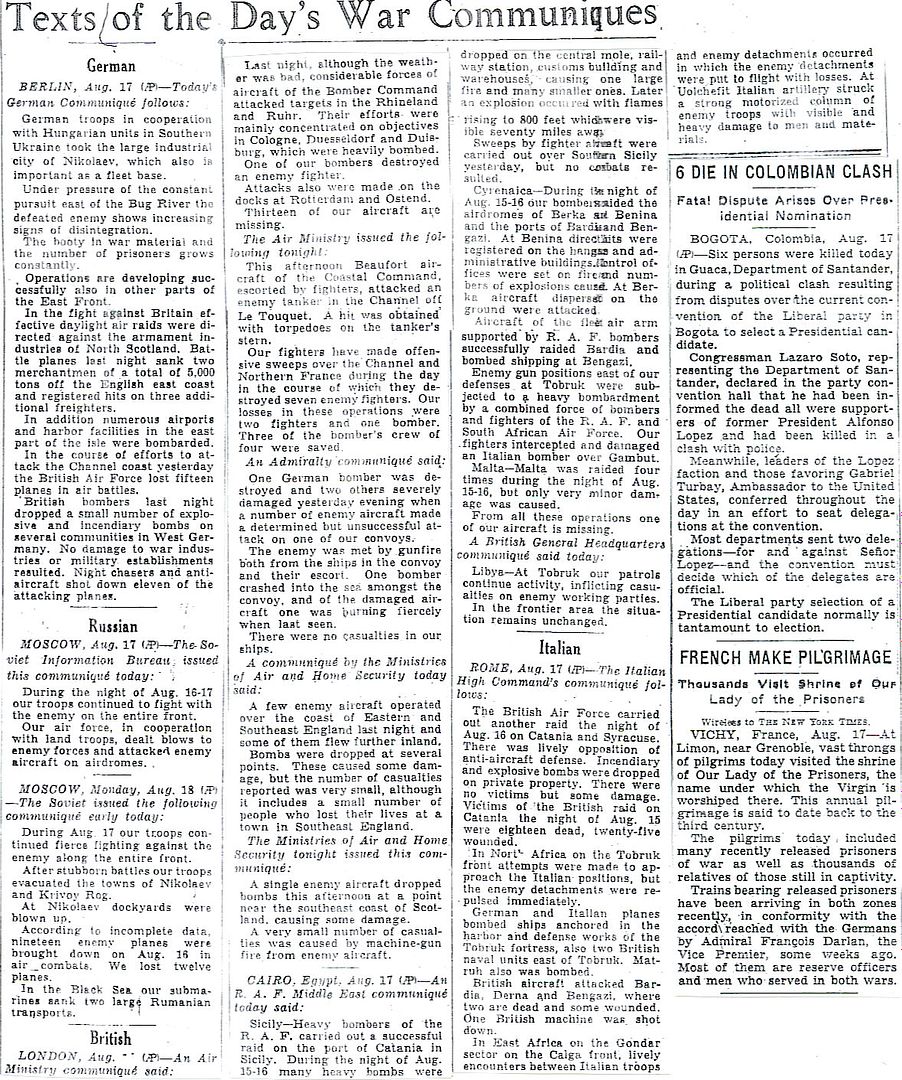
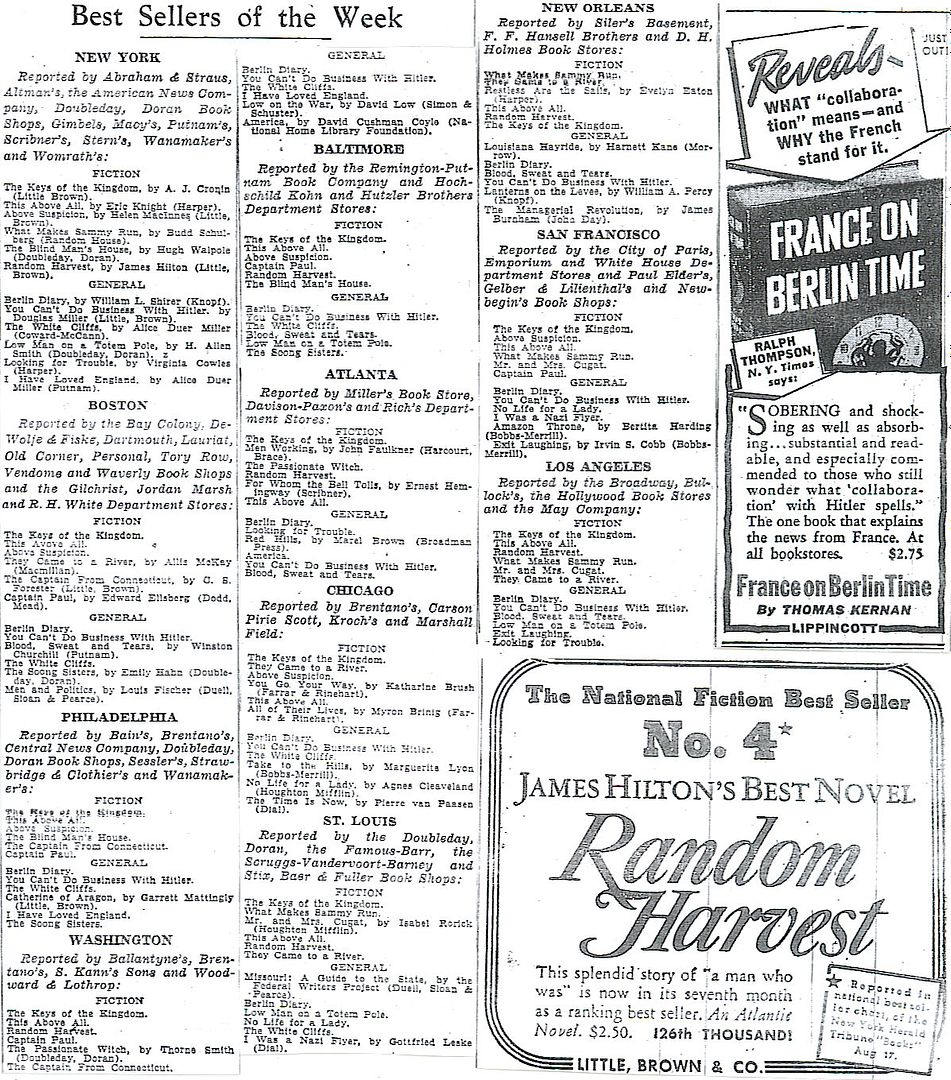
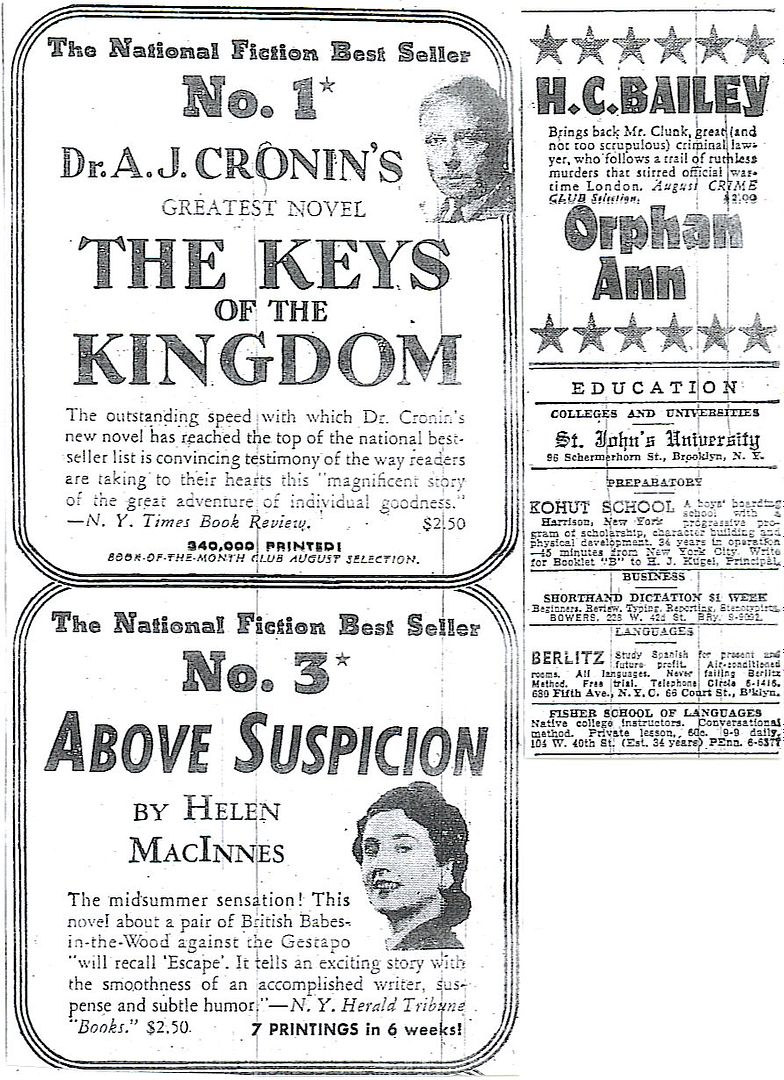
* Quarterly feature to follow evolution of American reading habits. “Random Harvest” is still doing well but the “The Keys of the Kingdom is the runaway best seller in fiction this week. It is #1 in every market except New Orleans, where it is #5. Has anyone read it? “Berlin Diary,” by our own William L. Shirer, is #1 in the General category. Here are the earlier lists. They are near the end of the post in each case.
5/19/41 Thread
2/17/41 Thread
11/18/40 Thread
8/19/40 Thread
5/13/40 Thread
2/19/40 Thread
10/23/39 Thread
Notice the small filler at the bottom of pg 3. The Tatuta Maru saga continues and gets strange.
http://www.onwar.com/chrono/1941/aug41/f18aug41.htm
Germans attacking southeast of Leningrad
Monday, August 18, 1941 www.onwar.com
On the Eastern Front... Budenny, commanding the Soviet armies in the Ukraine, begins to withdraw as many of his troops as possible behind the line of the Dniepr River. In the area of German Army Group Center there are fierce engagements near Gomel, east of the Pripet Marshes. In the north the German forces of Army Group North take Kingisepp, on the Luga River, east of Narva; there is also heavy fighting near Novgorod, on the Volkhov River, north of Lake Ilmen.
http://homepage.ntlworld.com/andrew.etherington/month/thismonth/18.htm
August 18th, 1941
UNITED KINGDOM: The National Fire Service was inaugurated today. 118,000 strong, with 180,000 auxiliaries and 60,000 women, under Sir Aylmer Firebrace, a former London fire chief. Some 1,450 previous commands have been merged into 37 fire forces and 200 divisions. Fire drills have been standardised and emergency water tanks are now installed on bomb sites.
Destroyer HMS Mahratta laid down.
Destroyer HMS Badsworth commissioned.
destroyer depot ship HNLMS Colombia is commissioned. (Dave Shirlaw)
GERMANY: Rastenburg: Hitler rejects proposals from General Franz Halder, the chief of staff, and Field Marshal Walter von Brauchitsch, the army C-in-C, for an attack on Moscow.
Hitler also orders the deportation of Berlin’s remaining 76,000 Jews to ghettoes in Poland.
Hitler also orders that the systematic murder of the mentally ill and handicapped be brought to an end because of protests within Germany. This program had been initiated in 1939 and 50,000 German adults and children had been killed before it was terminated. (Jack McKillop)
Cologne is raided by Blenheim’s of No. 2 Group RAF. Today they are escorted by the Westland Whirlwind twin-engined fighter. (22)
U-188 laid down . (Dave Shirlaw)
FINLAND: Undersecretary of State Sumner Welles informs the Finnish Ambassador Hjalmar Procope that Soviet Union is willing to discuss peace terms with Finland. The Soviets are even willing to modify the terms of the Peace of Moscow of 1940 (ending the Winter War) more advantageous to Finland. Welles stresses that he is merely passing the information on, not acting as an official middle-man. Stalin had earlier, on 4 Aug, written to Roosevelt that he would appreciate if Finland could be withdrawn from the war.
Procope replies by asking if the western powers are willing to give guarantees to Finland in the case Germany loses the war. Welles is unwilling to discuss the matter. In the end Finnish government is forced to give no definite answer to the tentave peace offer. As the German armies are advancing everywhere in the eastern front, there is perceived to be no sound basis for a peace between Finland and Soviet Union. (Mikko Härmeinen)
U.S.S.R.: The Soviet Southern Armies, under Budenny, begin a withdrawal behind the Dnieper. Gingisepp, on the Luga west of Narva falls to the Germans.
The German 1.Panzergruppe (von Kleist) establishes a bridgehead across the Dnepr at Zaporoshe. From Kairala in northern Finland, 20.Gebirgsarmee (Dietl) begins an offensive with the objective of capturing the vital Lend-Lease port of Murmansk. (Jack McKillop)
Soviet destroyer Statny is mined and sunk in Moon Sound. (Dave Shirlaw)
MEDITERRANEAN SEA: RN Submarine P33 is believed to have been lost in a depth charge attack off Tripoli on this day. The only clues to her fate were reports of a severe depth charge attack by P.32 and HMS Unique which appeared to come from the area allocated to P.33. Subsequent attempts by P.32 to contact P.33 were unsuccessful.
After hearing the depth charge attack, which may have foretold the demise of P.33, RN submarine P.32 attempts to manoeuvre into a position to attack a convoy of five merchant ships under escort in the swept channel approach to Tripoli Harbour. Realising that they were not in a good position to carry out an attack Lt. D. A. B. Abdy (Later Lt.Cdr.) decided to run under a minefield, running at full speed for about ten minutes until he believed that he had reached the swept channel.
Periscope depth was ordered and P32 was just rising when she struck a mine forward on the port side. The explosion put out all the lights, the forward control door jammed, she took on a heavy list to port and sank to the bottom, 210’ below the surface. In actuality, the whole of the boat forward of the control room had been destroyed, killing the eight crew members forward. The remaining 24 sought refuge in the after spaces. Once it was realised that the boat could not be saved or surfaced, the decision to attempt escape was taken. In Abdy’s opinion the engine room offered the brighter prospect of escape as he was concerned about the pressure being put on the forward control room door. However, taking into consideration the number of crew members in the engine room (23 besides himself) and the amount of time that P.32 had been submerged he decided to split the group up. The Coxswain (Petty Officer E. Kirk), and ERA Martin volunteered to join Abdy in an attempt to make what was believed to be the more dangerous escape via the conning tower.
Abdy and the coxswain escaped successfully but ERA Martin was dead on his arrival on the surface (in actuality, any successful escape, even with DSEA gear, was considered impossible beyond 150’). Both Abdy and Kirk were later picked up by an Italian naval vessel shortly after being spotted by an aircraft which had been searching the area after the mysterious explosion. When it was reported by Abdy that others would appear shortly, the Italians opted to remain for several hours but no other survivors were seen to escape. Adby and Kirk were made prisoners of war and eventually chosen for prisoner exchange in March 1943. Due to the belief that the escape hatch was a weak point during heavy depth charging (and the chance of escape from a sunk submarine in war time being considered remote), it was fairly standard for an iron bar to be welded over the escape hatches of HM submarines on active duty. It later came to light that, in all likelihood, this had been performed on P 32 during her last stop in port and that was the reason that no one emerged from the after portion of the boat. The truth of this thought has, to my knowledge, not been determined by divers... (Alex Gordon and Mark E. Horan)(108)
NORTH AFRICA: Tobruk: The eyes of the world have focused since April on this dusty, sand-blown seaport, much of it lying in ruins after four months of bombardment. In Berlin, the Göbbels propaganda machine has delighted in calling the Australian garrison “rats caught in a trap”. It was not long before the Aussies themselves took up the title and were calling themselves “the Rats of Tobruk.”
They beat off one massive German assault and have remained a major thorn in the flesh for Rommel, who desperately needs Tobruk’s port facilities to ease his heavily-stretched supply lines. Despite the Luftwaffe’s nightly bombings - the record so far is 21 raids between dusk and dawn - the real hazards for the garrison are boredom and monotony of a diet of bully beef, tinned stew and canned fruit supplemented by vitamin tablets. The local water, rationed to six pints a day per man, tastes foul.
For all the air-raids and frequent long-range bombardments, morale is good in Tobruk. The Aussies make their own bawdy stage entertainments, and their local newspaper Tobruk Truth, is printed each morning using BBC news.
Although the siege continues, night-time ferries have nonetheless brought in some supplies, and the Australians were delighted last night when Polish, British, South African and Indian troops broke through to join them after a daring naval operation in darkness.
CANADA: Minesweepers HMCS Fort William, Kenora and Milltown laid down Port Arthur, Ontario. (Dave Shirlaw)
U.S.A.: President Franklin D Roosevelt announces that the U.S. is ferrying combat aircraft via Brazil and Africa to the British in the Near East. The company that will ferry the aircraft is Pan American Air Ferries, a subsidiary of Pan American World Airways. This activity resulted from a meeting between Juan Trippe, the head of PanAm, and British Prime Minister Winston Churchill in London in June 1941. Over dinner, Churchill asked if PanAm could fly aircraft and supplies to Cairo, Egypt, to counter the Germans in North Africa. On his return to the U.S., Trippe met with President Roosevelt and was told to set up the routes across Africa as soon as possible; the U.S. Government also provided money to assist in this effort. Pan American Air Ferries was established on 24 July 1941, all available pilots were hired, and the operation began shortly thereafter. (Jack McKillop)
The government tasks the U.S. Coast Guard with enforcing laws to protect war-lanes in Alaskan waters. (Jack McKillop)
Destroyer USS Badsworth is commissioned. (Dave Shirlaw)
BRAZIL: A Panair do Brasil Lockheed 18-10 Lodestar, msn 18-2083, registered PP-PBD, crashes near Sao Paulo; all 8 aboard the aircraft are killed. (Jack McKillop)
ATLANTIC OCEAN: At 0250 U-38 sank the unescorted SS Longtaker. Hitting her in the bow and amidships. (Dave Shirlaw)
"Many Jews who had escaped the ghettos and camps volunteered to fight Nazis and Fascists.
Some 5000 joined the Polish Second Corps, formed in Russia in 1941, while about 30,000 others enlisted in the British Army.
Both groups later saw combat in Italy.
Here, Arab and Jewish recruits, composing the Auxiliary Military Pioneer Corps of the British Army, march side by side during a training exercise in Palestine."
"The most important Resistance group in Occupied France was the FFI (Free French Insurgency), whose troops are pictured.
Commanded by General Charles de Gaulle, the Free French opposed recognition of the Vichy regime, a puppet government established by the Nazis.
The FFI coordinated much of the resistance activity within Occupied France and established an army that would participate in the approaching reconquest of Europe."
I was just reading on wiki that the crew of the Robin Moor spent 2 weeks on a few lifeboats before being rescued.
http://en.wikipedia.org/wiki/Robin_Moor
Not much in this one - a shot down the top of a girl’s swimsuit and the statue in Paris.
Disclaimer: Opinions posted on Free Republic are those of the individual posters and do not necessarily represent the opinion of Free Republic or its management. All materials posted herein are protected by copyright law and the exemption for fair use of copyrighted works.